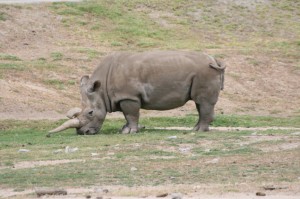Nancy Rogowski
 A recent edition of the ScienceTimes, a section of the NY Times includes several noteworthy animal articles. Elephants Get the Point of Pointing, by Carl Zimmer writes about a new research lead by Dr. Byrne’s suggesting elephants understand human pointing, a rare gift in the animal kingdom. Dr. Byrne’s states, “Even our closest relatives, like chimpanzees, don’t seem to get the point of pointing.” Researchers have done tests, such as putting food in one of two identical containers and then silently point at the one with food. Primates and most other animals studied fail the test, some have done well, such as domesticated mammals, especially dogs. These results have prompted researchers to speculate that during domestication animals evolve to become keenly aware of humans. Dr. Byrne’s began to wonder if elephants would pass the pointing test, so last year one of his students went to Zimbabwe, and for 2 months tested 11 elephants. The study found that 67.5% of the time elephants could follow the pointing. Dr. Byrne’s would also like to study the pointing test on whales and dolphins but thinks “they make elephants look easy to work with.”
A recent edition of the ScienceTimes, a section of the NY Times includes several noteworthy animal articles. Elephants Get the Point of Pointing, by Carl Zimmer writes about a new research lead by Dr. Byrne’s suggesting elephants understand human pointing, a rare gift in the animal kingdom. Dr. Byrne’s states, “Even our closest relatives, like chimpanzees, don’t seem to get the point of pointing.” Researchers have done tests, such as putting food in one of two identical containers and then silently point at the one with food. Primates and most other animals studied fail the test, some have done well, such as domesticated mammals, especially dogs. These results have prompted researchers to speculate that during domestication animals evolve to become keenly aware of humans. Dr. Byrne’s began to wonder if elephants would pass the pointing test, so last year one of his students went to Zimbabwe, and for 2 months tested 11 elephants. The study found that 67.5% of the time elephants could follow the pointing. Dr. Byrne’s would also like to study the pointing test on whales and dolphins but thinks “they make elephants look easy to work with.”
Think Elephant International, a not-for-profit organization that str

ives to promote elephant conservation through scientific research and educational programming announced a study on April 17, 2013 co-authored by 12-14 year old students from East Side Middle School in NYC, revealing elephants were not able to recognize visual cues provided by humans, although they were more responsive to voice commends. The study is a three-year endeavor to  create a comprehensive middle school curriculum that brings elephant into classrooms as a way to educate young people about conservation by getting them directly involved in work with endangered species. This research tested elephant pointing to find food hidden in one of two buckets, and the elephants failed this Continue reading
create a comprehensive middle school curriculum that brings elephant into classrooms as a way to educate young people about conservation by getting them directly involved in work with endangered species. This research tested elephant pointing to find food hidden in one of two buckets, and the elephants failed this Continue reading
Filed under: endangered species, IUCN | Tagged: animal advocacy, conservation, elephants, endangered species, environmentalism, meerkat, moose | 1 Comment »






